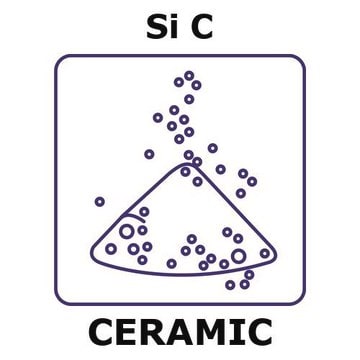594911
Silicon carbide
nanopowder, <100 nm particle size
Synonym(s):
Carbon silicide, Carborundum, Methanidylidynesilanylium, Silicon monocarbide
Sign Into View Organizational & Contract Pricing
All Photos(3)
About This Item
Linear Formula:
SiC
CAS Number:
Molecular Weight:
40.10
EC Number:
MDL number:
UNSPSC Code:
12352302
PubChem Substance ID:
NACRES:
NA.23
Recommended Products
form
nanopowder
surface area
70-90 m2/g
particle size
<100 nm
mp
2700 °C (lit.)
density
3.22 g/mL at 25 °C (lit.)
bulk density
0.069 g/cm3
SMILES string
[C-]#[Si+]
InChI
1S/CSi/c1-2
InChI key
HBMJWWWQQXIZIP-UHFFFAOYSA-N
Looking for similar products? Visit Product Comparison Guide
Related Categories
General description
Silicon carbide (SiC), also known as carborundum, is composed of silicon and carbon, forming a hard refractory ceramic material that exhibits extreme mechanical and thermal stability. This product is a SiC nanopowder with a particle size less than 100 nm and a high surface area of 70-90 m2/g. Our product is primarily made of the beta phase with approximately 3-15% adopting an amorphous structure. With a Mohs scale hardness of 9.5, silicon carbide is one of the hardest materials, which make its nanopowder useful in the production of abrasives for polishing and grinding and as a coating or composite material for high wear-resistance. SiC nanoparticles are also under research as sensors and imaging nanoprobes for bioscience and clinical diagnosis.
Application
- Overview of silicon carbide power devices: This document provides a comprehensive review of the characteristics and applications of silicon carbide (SiC) in power devices, discussing its advantages over traditional silicon devices in handling high voltages and efficiencies (Choi, 2016).
Physical form
primarily beta phase (3-15% amorphous)
Storage Class Code
11 - Combustible Solids
WGK
nwg
Flash Point(F)
Not applicable
Flash Point(C)
Not applicable
Personal Protective Equipment
dust mask type N95 (US), Eyeshields, Gloves
Choose from one of the most recent versions:
Already Own This Product?
Find documentation for the products that you have recently purchased in the Document Library.
Customers Also Viewed
Martial Hamon et al.
EuroIntervention : journal of EuroPCR in collaboration with the Working Group on Interventional Cardiology of the European Society of Cardiology, 8(9), 1006-1011 (2013-01-24)
To report the four-month and nine-month angiographic results as well as one-year clinical follow-up from the first-in-man study with the silicon carbide and sirolimus-eluting bioabsorbable polymer (poly-L-lactic acid (PLLA) polymer) -coated cobalt-chromium Orsiro stent. A group of 30 patients with
Bálint Somogyi et al.
Nanoscale, 4(24), 7720-7726 (2012-11-09)
Molecule-sized fluorescent emitters are much sought-after to probe biomolecules in living cells. We demonstrate here by time-dependent density functional calculations that the experimentally achievable 1-2 nm sized silicon carbide nanocrystals can emit light in the near-infrared region after introducing appropriate
Mónica Fernández-Perea et al.
Optics express, 20(21), 24018-24029 (2012-11-29)
We have developed new, Mg/SiC multilayer coatings with corrosion barriers which can be used to efficiently and simultaneously reflect extreme ultraviolet (EUV) radiation in single or multiple narrow bands centered at wavelengths in the spectral region from 25 to 80
A Oliveros et al.
Conference proceedings : ... Annual International Conference of the IEEE Engineering in Medicine and Biology Society. IEEE Engineering in Medicine and Biology Society. Annual Conference, 2012, 1643-1646 (2013-02-01)
Silicon Carbide (SiC), has been shown to be a bio- and hema-compatible substrate that could potentially be used in biosensor applications. The development of a viable biorecognition interface using SiC as the substrate material for bio-detection is described. Surface modification
Alexandra Oliveros et al.
Biomedical microdevices, 15(2), 353-368 (2013-01-16)
Silicon carbide (SiC) has been around for more than 100 years as an industrial material and has found wide and varied applications because of its unique electrical and thermal properties. In recent years there has been increased attention to SiC
Our team of scientists has experience in all areas of research including Life Science, Material Science, Chemical Synthesis, Chromatography, Analytical and many others.
Contact Technical Service



